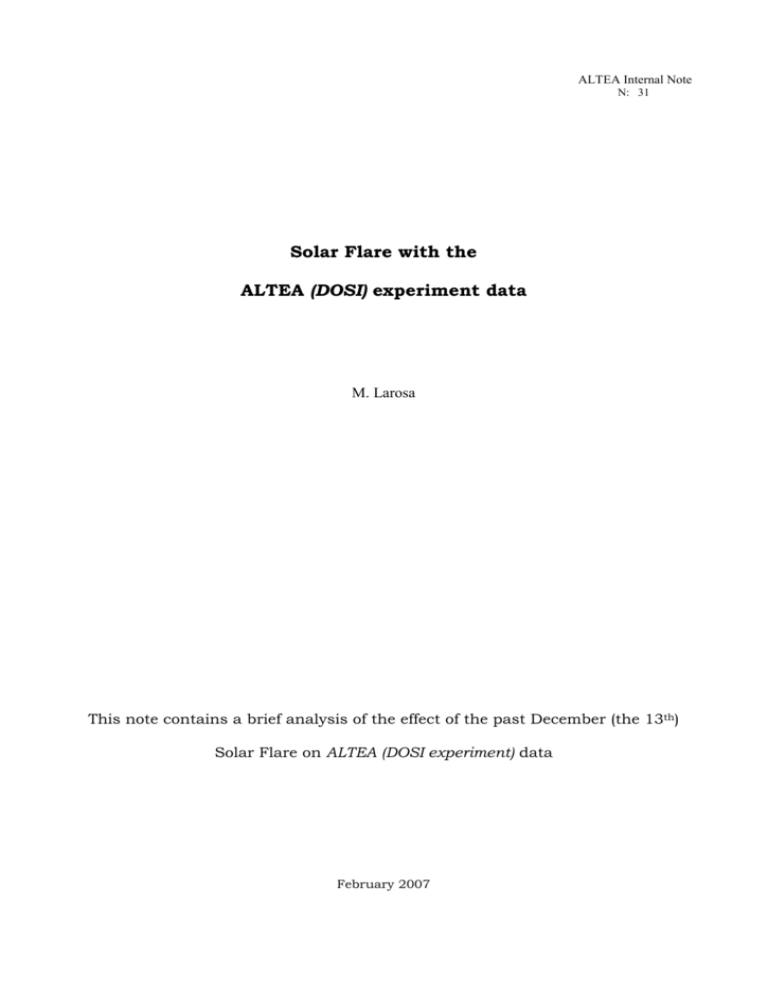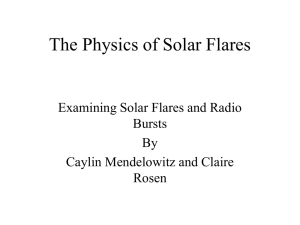Solar Flare with the ALTEA (DOSI) experiment data
advertisement

ALTEA Internal Note N: 31 Solar Flare with the ALTEA (DOSI) experiment data M. Larosa This note contains a brief analysis of the effect of the past December (the 13th) Solar Flare on ALTEA (DOSI experiment) data February 2007 ALTEA Internal Note N: 31 This note is devoted to the analysis of a solar flare role on the ALTEA (DOSI) data. A solar flare is a violent explosion in the Sun's atmosphere with an energy equivalent to millions of hydrogen bombs (109 megatons), traveling normally at about 0.1% the speed of light, that happens when energy stored in twisted magnetic fields (usually above sunspots) is suddenly released. Solar flares take place in the solar corona and chromosphere, heating plasma to tens of millions of K, and accelerating the resulting electrons, protons and heavier ions to near the speed of light. They produce a burst of radiation across the electromagnetic spectrum at all wavelengths from long-wave radio to the shortest wavelength X-rays and γ-rays. Most flares occur around sunspots, where intense magnetic fields emerge from the Sun's surface into the corona. In fact, they are known to be associated with the magnetic field that thread the solar corona in active regions around sunspots. One favored explanation is that they occur when magnetic fields in the Sun pointing in opposite directions interact strongly with each other. There typically is a correlation between the frequency of flares and the number of sunspots. The frequency of occurrence of solar flares varies, from several per day when the Sun is particularly active, to less than one each week when the Sun is quiet. Solar activity varies with an 11-year cycle (the Solar Cycle). At the peak of the cycle there are typically more sunspots on the Sun, and hence more solar flares. Scientists classify solar flares according to their X-ray brightness in the wavelength range 1 to 8 Angstroms. The intensity of a solar flare has different behaviors according to the electromagnetic wavelength into account. This implies the presence of different flare trends probably due to different physical processes or different steps on the flare evolution. Three distinctive solar flare phases can principally be traced i.e. a precursor phase, where a little amount of energy is released as a prelude of the principal (central) event; the impulsive phase, where the energy is ejected in sudden explosions and finally a long duration main phase. Solar flares have been known to affect the electro-transmission of many earthy communication devices including computers, cell phones and automobiles. Moreover, energetic particles accelerated in solar flares, which escape into interplanetary space, are dangerous to astronauts and to electronic instruments in space. As a consequence, the analysis of this kind of phenomena within the ALTEA program can turn out to be remarkable. The ALTEA program belongs in fact to a research field aimed at studying the interaction between the cosmic radiations and the Central Nervous System during long manned missions on board the International Space Station. In particular, ALTEA Space, the main in-space experiment of the ALTEA project devoted to detect and study the charged particles hitting the astronaut’s head, performing functional dosimetry space measures can provide some hints on the solar flare issue. It is worth stressing that ALTEA Space has two operative configurations of working: 1) DOSI mode, that is an unmanned experiment where only the Silicon Detector System (SDS) with the six Silicon Detector Units (SDUs), the Data Acquisition Unit (DAU) and the Laptop are active; 2) CNSN mode, during which the interactions between the cosmic ray particles ALTEA Internal Note N: 31 and the Central Nervous System are continuously monitored and the help of some selected crew member is needed as well. All the ALTEA subsystems are active in this modality. The solar flare has been observed during DOSI operative mode of ALTEA-Space experiment. The most recent solar flare, happened on December the 13th, has therefore been recorded even by ALTEA-Space (DOSI) experiment. Figure1 represents in fact the plot of DOSI-data particle rate acquired with a threshold of 10 MIP in Normal mode and for a period of four days (Dec. the 11th to the 14th, 2006). The expected trend, i.e. the latitude oscillations, the longitude modulations and the various ISS passages over the South Atlantic Anomaly, is still visible, even if the particle countings are really too high (almost by a factor of 10, on Dec. the 11th and the 12th) with respect the observed mean values. Actually this behavior can be related to the fact that the data acquisition was going on with one working SDU only or maybe related to the so called precursor phase of the flare. Nonetheless, in the plot is well visible the area with a certain number of peaks in correspondence to Dec. the 13th and lasting about 4 hours, that is undoubtedly connected to the solar flare impulsive phase, where in fact there is a sudden and enormous increase of the particle countings. The next day rate-trend can be instead associated to the main phase of the flare, where the number of particles/s still remain very high with respect the previous observed ones. Figure 1: Plot of the particle rate at 10 MIP threshold in Normal mode for the period of days 11/12 to 14/12/2006 and with one SDU on. This period of time includes a Solar Flare event revealing its presence with an abrupt rate increasing in correspondence of December the 13th. The main flare phase is visible too in correspondence of December the 14 th. ALTEA Internal Note N: 31 Figure 2 and Table 1 show the particle rate obtained considering the DOSI data acquired in Normal mode with a 10 MIP threshold. Each line in the figure corresponds to a single acquisition and ach of those acquisitions is uniform for number of SDUs working but not for lasting time. The behavior of particle rate is almost stable for all the six SDUs, even if SDU2 and SDU5 feature the most number of counting, maybe because of their sticking out position. As can be seen, there is a huge contribution to these countings coming from the period of time including the solar flare day, providing in this way further evidence on the flare presence and its role. days of data acquisition (GMT) 238-240 274-279 279-291 291-306 306-314 314-321 321-322 323-340 340-348 351-365 Rate (particles/s) Rate (particles/s) Rate (particles/s) Rate (particles/s) Rate (particles/s) Rate (particles/s) SDU1 SDU2 SDU3 SDU4 SDU5 SDU6 6.4346 6.0664 5.9174 3.4580 5.7666 4.0504 5.1899 5.2539 7.0380 4.9608 7.7367 8.7760 8.1292 5.5645 7.0825 8.7247 6.1399 9.9180 84.886 7.7435 6.8251 6.4754 6.4063 3.4956 6.0757 1.2114 5.9694 6.5503 9.5789 6.1874 6.5893 4.6576 4.6619 4.6579 4.6449 1.4313 3.8590 4.15 5.3145 5.4086 6.9417 19.838 9.7505 4.8712 7.1815 3.1862 6.8987 6.6717 11.874 8.9367 6.6452 6.2559 6.3282 3.6570 6.5543 0.4122 8.6609 13.021 9.3753 6.2112 Total Time (min) 2625 7288 16848 20451 11338 9791 1709 22731 10921 19880 Table 1: Particle countings of the six SDUs for several periods of time. In red, the period of time including the solar flare event. Figure 2: Plot of differences in counting for the six SDUs. In this case too it is possible to identify the solar flare event by the huge contribution coming from SDU2 during the period of time concerning the flare. ALTEA Internal Note N: 31 An interesting observation comes from studying the rate of the relativistic particles, showed in Figure 3. Comparison with Figure 2 reveals how the shape of the rate, though lowered is still respected, with the passages over the South Atlantic Anomaly dominating as well. The Solar Flare event is well noticeable too. Figure 3: Plot of the relativistic particle rate at 10 MIP threshold in Normal mode for the period of days 11/12 - 14/12/2006 including the December the 13th Solar Flare event. In Figure 4 instead the rate of the relativistic particles with Z>5 is plotted. The flare event is still predominant with respect the whole rate trend, while the peaks relative to the South Atlantic Anomaly are suppressed, as expected, since the trapped particle component is constituted by protons and ALTEA is not sensible to low Z high energy component of the particle flux. Figure 4: Plot of the rate for relativistic particles with Z>5, acquired at 10 MIP threshold in Normal mode and detected during the period of days 11/12 - 14/12/2006 including the December the 13th Solar Flare event. ALTEA Internal Note N: 31 As can be seen in Figure 5, the previously indicated trend is more evident if one considers the rate of relativistic particles with 5 < Z < 10, where the SAA passages are cut away. Figure 5: Plot of the rate for relativistic particles with 5 < Z < 10, acquired at 10 MIP threshold in Normal mode and detected during the period of days 11/12 - 14/12/2006 including the December the 13th Solar Flare event. Finally, in Figure 6 comparison between the energy spectra of DOSI data acquired in Normal mode (with 10 MIP threshold) and collected in periods of one week each is shown. As can be seen, even if the event statistics is not enough high to resolve nuclei above Silicon, peaks in the spectrum concerning the solar flare week are higher and more definite with respect their counterpart of the 2007 January week plot, giving thus another evidence of the flare role. Figure 6: Energy plots comparison, referring to two different weeks of DOSI data, acquired in Normal mode at 10 MIP threshold. The blue spectrum concerns the December solar flare while the red one involves 2007 January data. On the X-axis are reported ADC channels while the number of events is on the Y-axis. ALTEA Internal Note N: 31 ALTEA Internal Note N: 31





